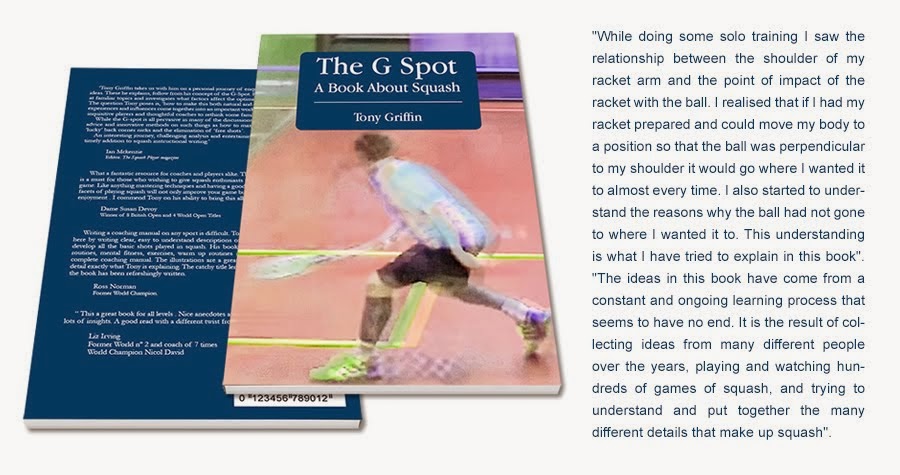G EVOLUTION* A different way of helping squash players evolve and change
In July I Presented the G Evolution process to the Catalan Squash Federation and a reduced number of their coaches in course entitled “A SQUASH COURSE FOR COACHES - Only For Coaches willing to think out of the Box”.
The question being : Is the challenge in teaching or having players learn and evolve?, teaching does not automatically equate to learning. The Gevolution process is focused on learning and transforming.
Now the Catalan federation is doing a second course with experienced coaches. We will do a study comparing the changes in pupils who are using normal training methods and those using the G evolution process
After writing my book “The G Spot, A Book about Squash” I have been experimenting and researching with sports science concepts for the last 3 years. Differential Learning from Wolfgang Schollhorn (University of Mainz Germany) and Deporte & Complejidad (Sport & complexity) written by Natalia Balague and Carlota Torrents (Barcelona Sports University I.N.E.F.) who also lead a sports science research group by the same name. I was also invited to participate in their recent research group weekend conference.
Here are some of main concepts I have been experimenting with for squash. Differential Learning and working in the present (Schollhorn). He has scientifically proved (in multi discipline training tests) that repetition is the least effective road to change… He also says that age is not a limiting factor for change, our experience with squash with players from 11 to 64 yrs old coincides with this. What does this imply for squash training where repetition is ever present?.
From Balague & Torrents, I have been experimenting with working with constraints (limits) which I have related principally to the primary movements (swing, body position, movement to and from the ball watching the ball and the tactics) although there are many more. The concept of Caos – Caos is when the primary movements lose their form or structure (both in training and matches), so basically those moments when we have that feeling that we’ve “lost it”. I have been looking at how caos effects learning and our ability to retain a new or changed movement or habit? They also talk about how each movement or habit comes from a neuron path or cell memory that we have created. Can and how do we create a new habit?
They talk about the tendency in modern sport to isolate the different aspects of the sport and train them separately in the hope that they come together in match context whereas we should be looking more at understanding how their interrelationship leads us to perform at an optimum level.
These ideas has lead me to look closer at how we watch the ball and the following questions. Can we teach watching the ball? Can we improve how we watch it?. What are the different parts or areas that make up watching the ball? Are we watching the ball in the moment of impact – does hitting the ball imply/equate to watching at the moment of impact? How watching the ball relates to our movement and orientation in space. I have also been researching the relationship between insecurity/doubts/fear and watching the ball. Does insecurity lead to disconnecting our eyes from the ball? What comes first insecurity, doubts or fear that lead to disconnection or is it the other way round - disconnection with the ball leads to insecurity, doubts or fear?. Is how we watch the ball related to our ability to create improved movements or habits?
Another question I have asked myself is what if the habit we have for hitting the ball or moving is based on moments of insecurity went we were learning, does this condition how were are able to evolve and improve?
The G evolution process also appears to have therapeutic value. I have been working with teenagers with Cerebral palsy, Dispraxia y orientation in space difficulties and they all have made surprising changes. It is too early to generalise about the therapeutic value but it something we are actively working on. My son Liam has a very slight cerebral palsy and a lazy eye, With his permission we’ll be sharing a case study about his squash evolution.
“Squash Project” on the Costa Brava is first squash academy to integrate the G evolution concept into their training programs. “G evolution simply opens new doors into ways of helping players change. After 1 month using G Evolution we are already seeing clear changes in some players ” Xavi Blasco, Squash project head coach https://www.facebook.com/498407267207603/photos/504364499945213/
On court with Ona Blasco, US Open Under 11, Under 13 Nº1 European ranking & Spanish Champion
In the G evolution course and process, Tony challenges conventional thinking and training methods. His focus is on players learning and not teaching them, it leads to change!. It is based on sports science concepts and not intuition, so it takes the coach and players to a clear understanding of how transformation occurs, it is not random.
I have been coaching and watching coaches work for more than 30 years so over the last 2 years I have been following special interest his research and the development of G evolution. I have seen changes in Tony´s son Liam who has slight cerebral palsy and orientation in space issues that I did not think were possible. He is also working with other teenagers with Dyspraxia and motor neuron difficulties and they are also making surprising changes.
I fully recommend the G evolution process for anyone looking to make real changes. It is fascinating!
Albert Casanye - Squash Club Owner and Distributor Tecnifibre









